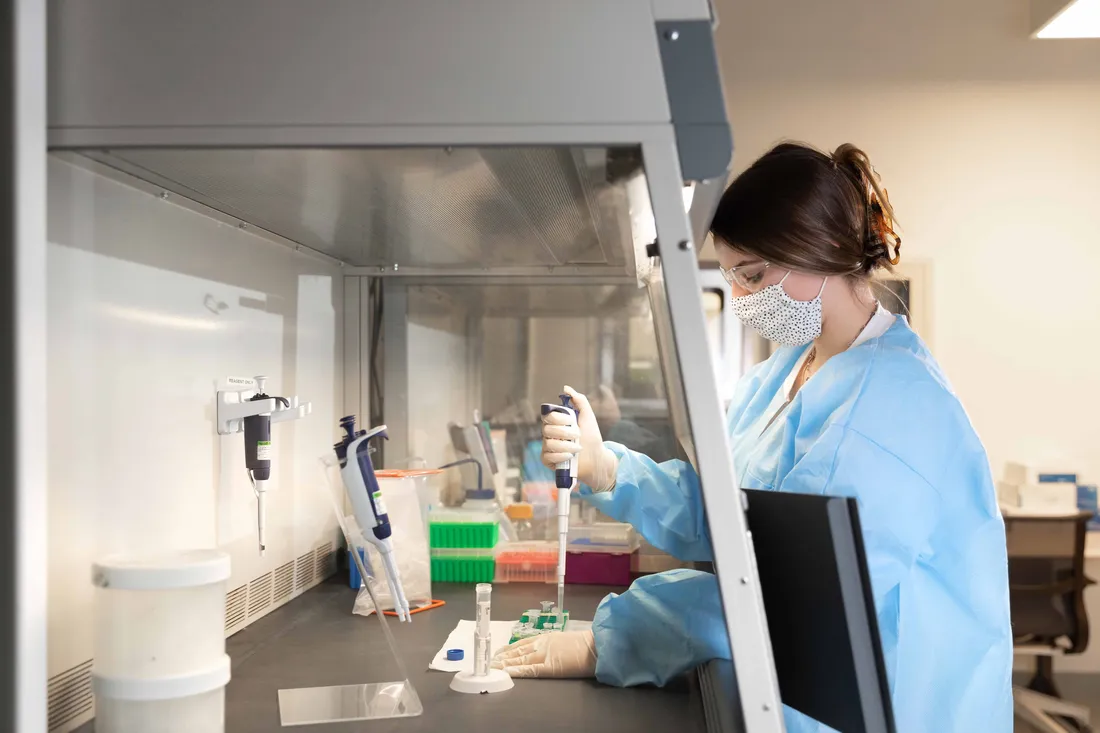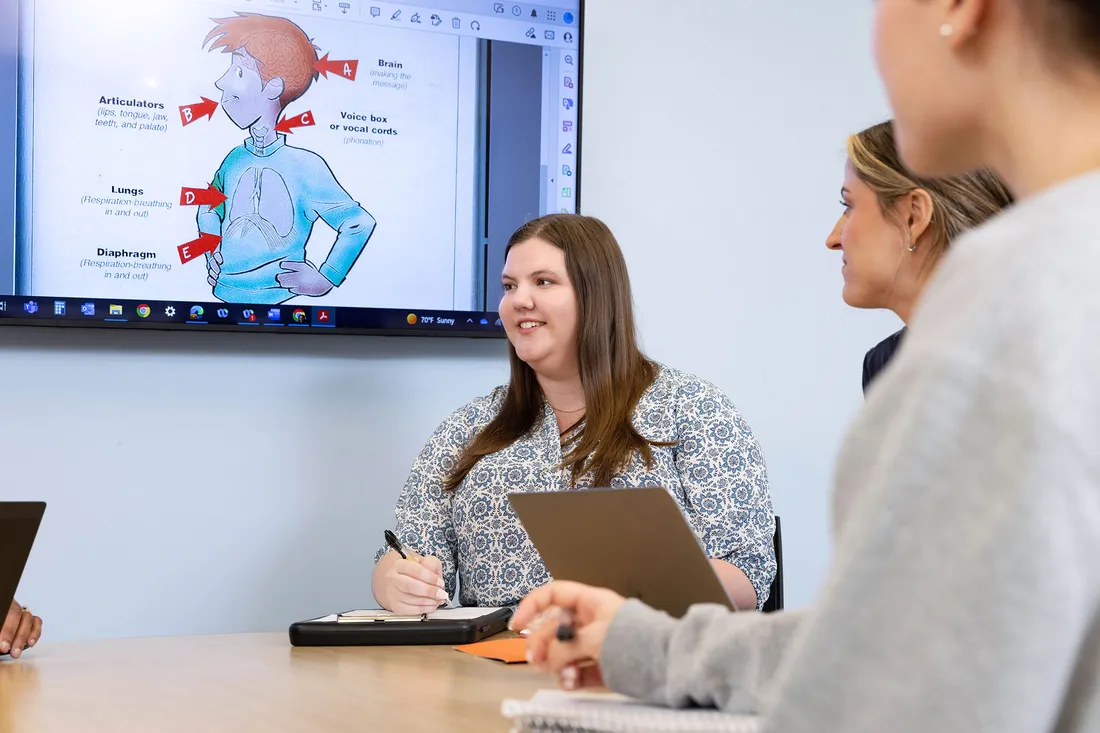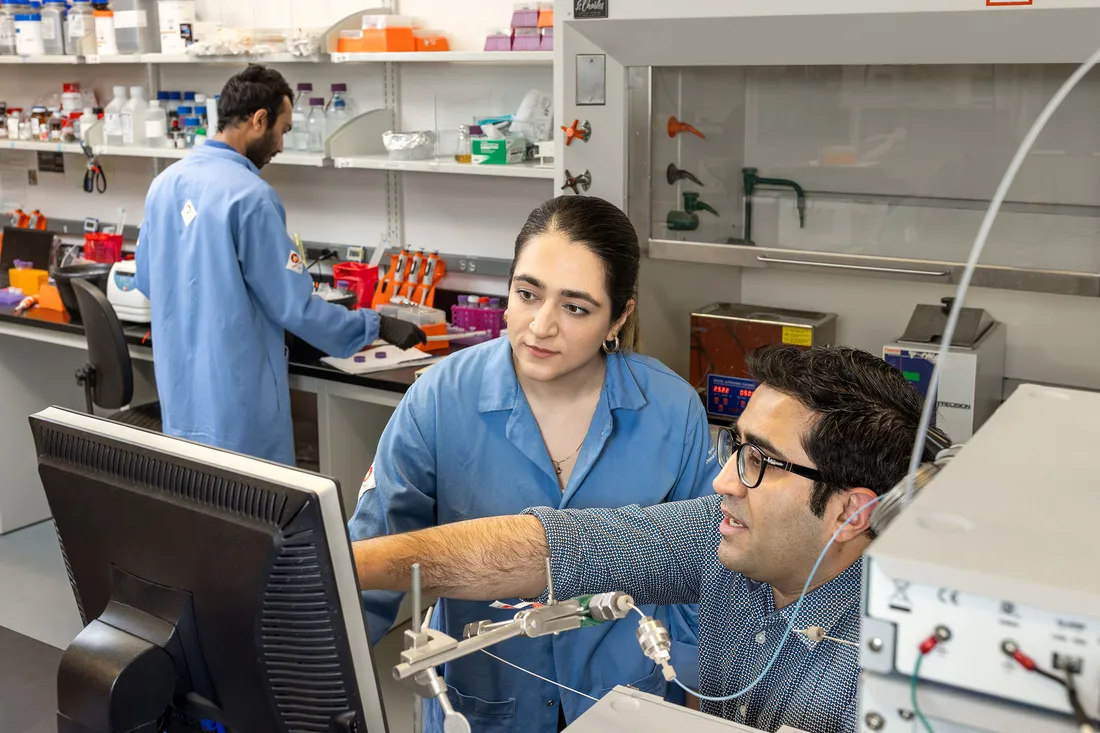
Professor Davoud Mozhdehi (right) discusses research with chemistry doctoral student Faeze Mousazadeh. Both Mousazadeh and chemistry doctoral student Kavindu Kolamunna (left) are members of Mozhdehi’s research lab team.
Davoud Mozhdehi, associate professor of chemistry in Syracuse University’s College of Arts and Sciences, likes to tinker with proteins. Through protein engineering, he believes there’s much to discover about the inner workings of lipidated proteins, which are equipped with oil-like appendages (lipids) that interact with cell membranes and are vital to cell functions like signaling and trafficking. “We’re trying to develop platforms to facilitate attaching lipids to proteins and to use the unique properties of lipids to tune the properties of proteins for various applications,” he says.
By learning how different groups of lipidated proteins work, Mozhdehi and his research team—which includes two postdoctoral researchers, 10 graduate students and undergraduates—seek to advance understanding about how they’re assembled for specific tasks, including working as sensor switches to regulate cell behavior and forming biocompatible nanoparticles for drug delivery. “These nanoparticles can encapsulate anti-cancer drugs and then effectively deliver them to cancer cells,” he says.
Forming Lipidated Proteins
Lipidated proteins are produced by attaching lipids to proteins through a process called post-translational modification (PTM), and they influence protein structure and dynamics. While lipidated proteins drive cell function, incorrect lipid attachment can disrupt these processes and lead to various diseases, such as metabolic disorders and neurodegenerative diseases. Mozhdehi and his research team collaborate with researchers from Syracuse and other universities, exploring how lipidated proteins form, change the properties and characteristics of proteins, interact with water and cell membranes and can be used for therapeutics. “The universe of these accessories—these little tags that you can add to proteins to give them specialized functions—is hundreds of times larger than the universe of the proteins we already know,” he says. “They have a significant impact.”
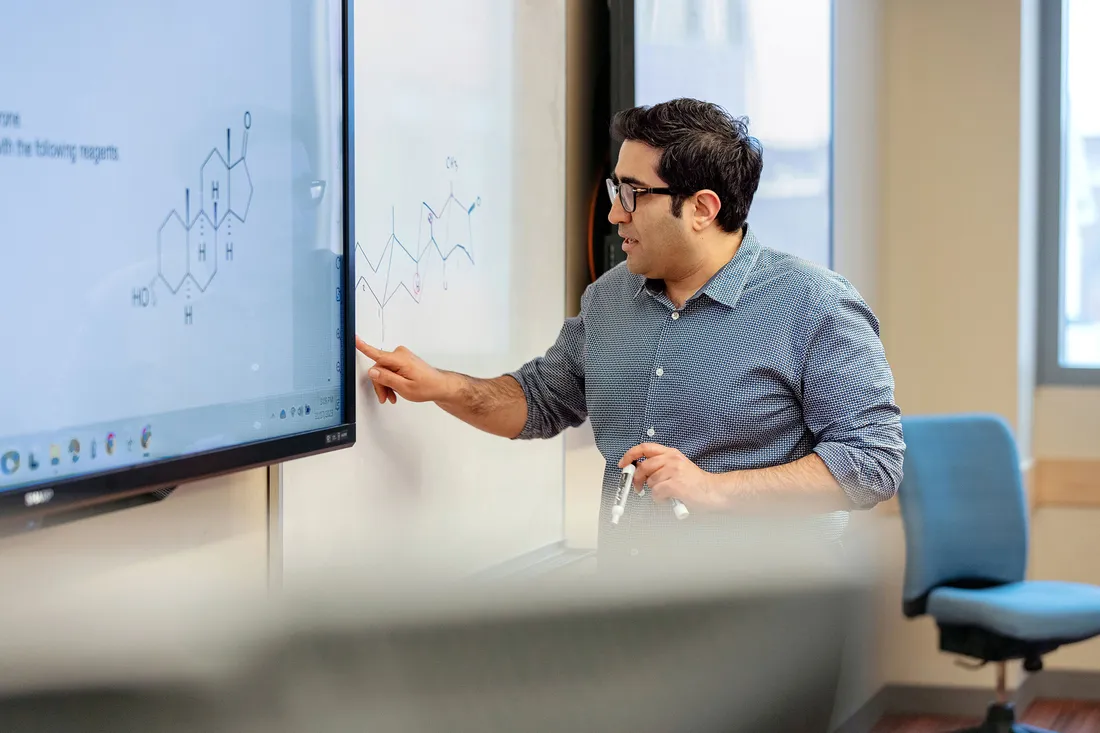
Professor Mozhdehi covers the chemical structure of a steroid lipid in a lecture on the organic chemistry of biological molecules.
A materials chemist by training, Mozhdehi was drawn to investigating these proteins because of their ability to perform complex functions and—in contrast to petroleum-based synthetic materials—they’re sustainable. For inspiration, he looks to nature. As an example, he cites mussels that adhere to surfaces underwater—a function he attributes to a lipidated protein. “It’s difficult to make proteins with the same pattern of these accessories that are found in nature. Most of the big picture research I do, even before I get into the protein, is to try to understand how nature creates these materials that sometimes have properties beyond synthetic materials,” says Mozhdehi, a member of the University’s BioInspired Institute who works at the interface of chemistry, biology and materials science.
Building a Knowledge Base
One drawback of experimenting with lipidated proteins is they are costly and time consuming to create, Mozhdehi says. However, with the support of a grant from the National Institute of General Medical Sciences, Mozhdehi and his research team developed an innovative and inexpensive solution using E. coli bacteria. By genetically engineering the bacteria—which has long been used to make proteins but is unable to perform lipidation—they can now produce and customize lipidated proteins. This streamlined process—for which Mozhdehi received a patent—will allow scientists to change the structure of lipids and proteins more efficiently, facilitating medical research that will improve understanding of their role in various diseases. Mozhdehi employs the process as part of a National Science Foundation (NSF)-funded project that he’s collaborating on with Shikha Nangia, a biomedical and chemical engineering professor in the College of Engineering and Computer Science. Through a combination of experiments, computational modeling simulations and machine learning algorithms, they are building customized libraries of lipidated proteins. The libraries help them develop design rules for nano-biomaterials with specific applications, particularly for materials science and health care.
Dr. Mozhdehi has been very helpful and understanding toward my research. He has always been very supportive of me, especially when I may have made an error or come across a problem. This is what makes the lab so enjoyable.”
Tatum White ’24
Greasing the Protein Wheels
Lipidated proteins look like grease, are hydrophobic and “grease proteins’ wheels,” Mozhdehi says. Under certain conditions, when they interact with water molecules at the protein-cell membrane interface, they form sticky droplets (protein condensates) that are involved in signaling and determine pathways for proteins to do their work, he says.
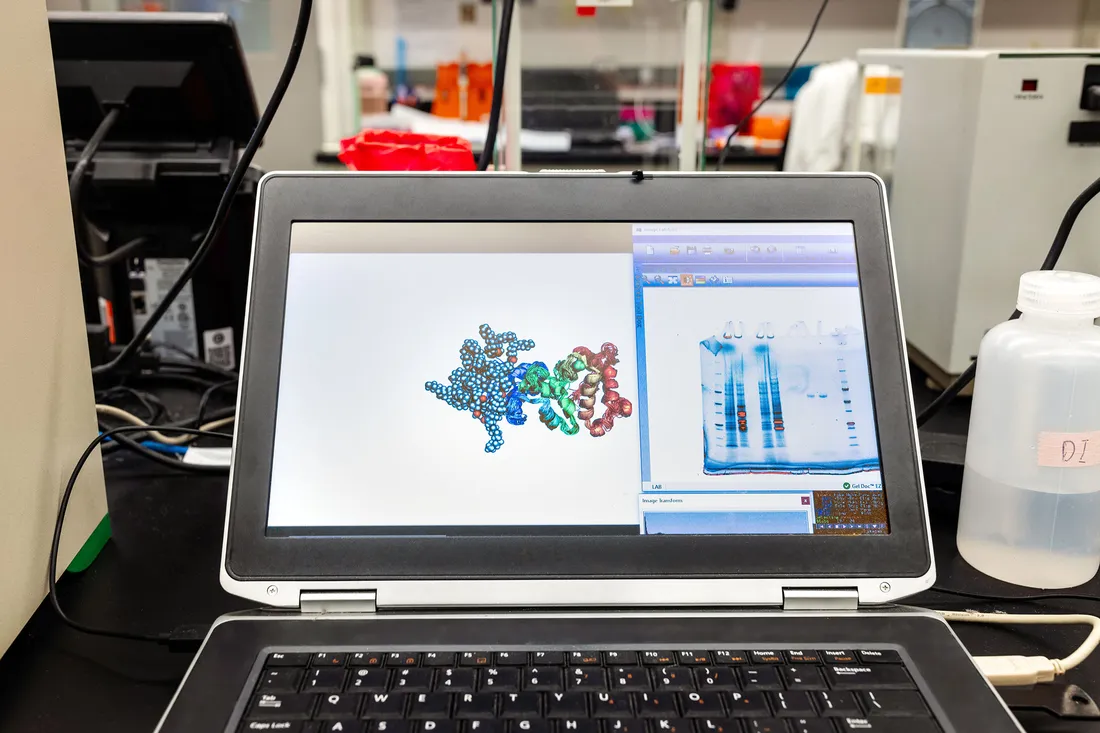
The Mozhdehi lab’s research on lipidated proteins integrates experimental analysis and simulation insights.
In research reported in the Journal of the American Chemical Society in February, Mozhdehi and his team, including doctoral student Zhe Zhang G’21 and lab technician Christopher Lynch ’22, collaborated with Penn State researchers, led by Professor Paul Cremer, to examine how lipid length influences the thermodynamics and kinetic stability of the droplets in phase separation. “Matching nature’s mastery of PTMs to manipulate all-aqueous interfaces would confer better control over the formation, material properties, and performance of protein condensates, potentially paving the way to use this class of materials to replace traditional oil-based emulsions in food processing, cosmetics, biosensing, enrichment and purification of biologics, artificial cell design, and other biomedical and emerging applications,” they wrote.
Creating Undergraduate Research Opportunities
Mozhdehi regularly engages undergraduates in research projects. Medicinal chemistry major Tatum White ’24 worked in his lab for the past three semesters. “Dr. Mozhdehi has been very helpful and understanding toward my research,” says White, who plans to attend medical school. “He has always been very supportive of me, especially when I may have made an error or come across a problem. This is what makes the lab so enjoyable.”
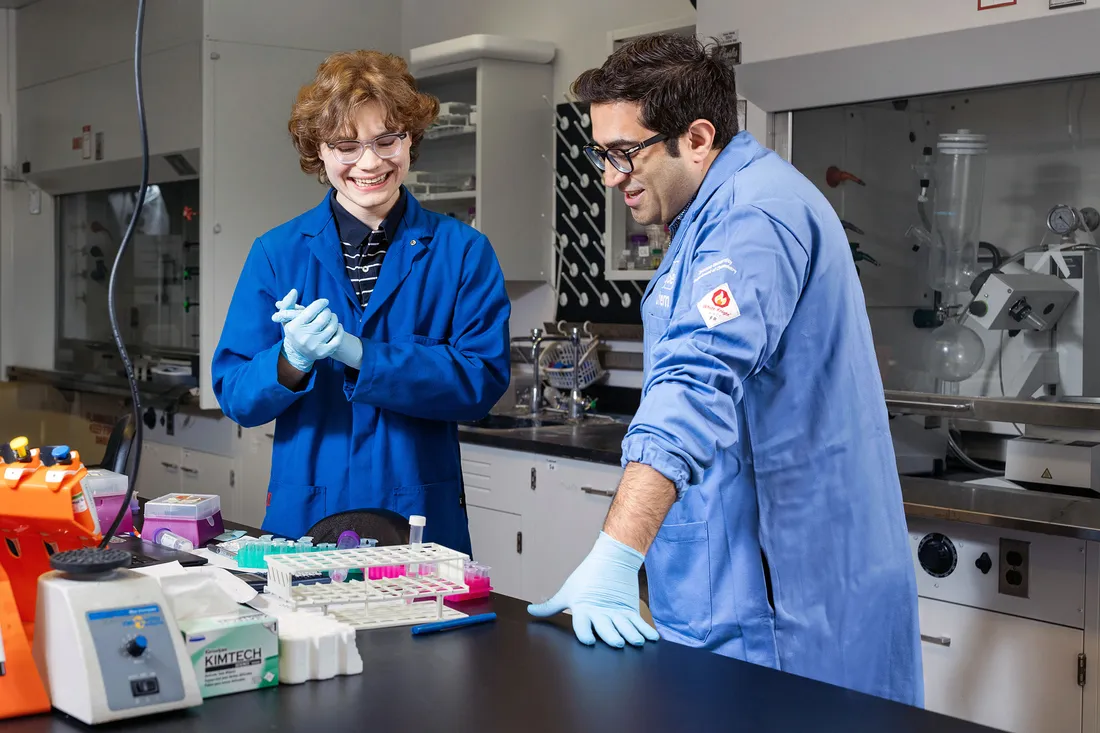
Professor Mozhdehi discusses experimental results with Christopher Lynch ’22, an undergraduate researcher in Mozhdehi’s lab who now serves as his lab technician.
White and Rayla Clemons ’24, also a medicinal chemistry major, did research on a project involving how a lipidated protein switch would act as a smart sensor to detect and target cancer cells for treatment with therapeutics. This liposwitch, a nanoparticle that combines properties of two proteins, is responsive to the presence of both calcium—which triggers movement and aggregation—and elevated temperature, which kills cancer cells. The liposwitches would enter cells and remain inactive. At a specific temperature, they would activate in cancer cells, aggregating and releasing anti-cancer drugs. “We’re trying to demonstrate that this can be used to selectively kill the cancer cell,” he says. “It’s like creating a Trojan horse.”
As Mozhdehi continues to explore the complex properties and applications of lipidated proteins, he keeps scalability and commercialization in mind and notes the Food and Drug Administration has only approved a few lipidated proteins for use as drugs. “It really shows the asymmetry between the prevalence of this protein inside our body and our ability to use lipidation to create therapeutics or to change the properties,” he says. And through his efforts, Mozhdehi would like to help change that.

